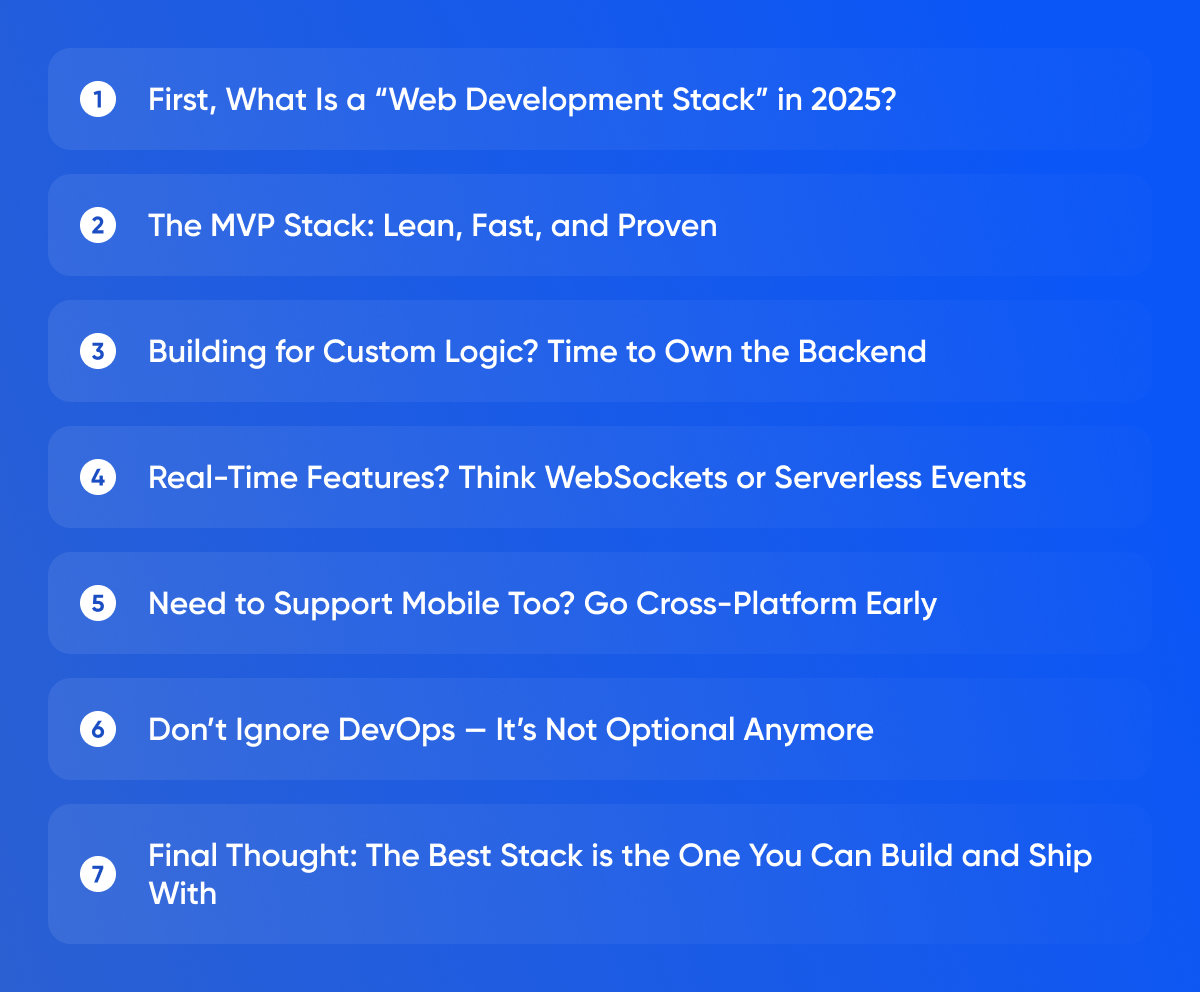There’s a lot of noise out there. Every month a new JavaScript framework goes viral. Every dev forum debates serverless vs monolith, GraphQL vs REST, Vue vs React. And if you’re a founder or product lead trying to launch a custom web app, it’s easy to get lost in the hype.
Here’s the truth: you don’t need the flashiest, trendiest stack. You need a stable, scalable, and understandable tech foundation that gets you from v1 to revenue without unnecessary complexity.
At Movadex, we’ve built dozens of custom products — marketplaces, SaaS tools, internal dashboards, mobile-first platforms — and we’ve seen what works in the real world, not just in conference talks. This post is your no-BS guide to choosing the right web dev stack for your project.

First, What Is a “Web Development Stack” in 2025?
Your web stack is the combination of tools and technologies that power your app — both what users see (frontend) and how data, logic, and integrations run behind the scenes (backend).
A modern stack typically includes:
-
A frontend framework (React, Vue, Svelte, etc.)
-
A backend environment (Node.js, Django, Rails, etc.)
-
A database layer (PostgreSQL, MongoDB, etc.)
-
APIs (custom-built, REST, GraphQL)
-
DevOps infrastructure (hosting, CI/CD, monitoring)
The best stack for your project isn’t about trends. It’s about context: your product goals, your team, your timelines, and the user experience you’re trying to deliver.
The MVP Stack: Lean, Fast, and Proven
If you’re validating an idea and need to get to market fast, go with a lean stack that maximizes speed and minimizes over-engineering.
A proven combo:
-
Frontend: React (with Next.js for SSR and routing)
-
Backend: Firebase or Supabase (for auth, DB, serverless functions)
-
Hosting: Vercel or Netlify (CI/CD built in)
-
Database: Postgres (via Supabase) or Firestore
This setup is ideal if your app doesn’t require heavy custom logic yet. You can launch in weeks, get real user feedback, and scale up or migrate later. Plus, the ecosystem is mature, meaning strong docs, support, and integrations.
Building for Custom Logic? Time to Own the Backend
If your app needs non-trivial logic — user roles, billing workflows, approval queues, complex data relationships — Firebase alone won’t cut it. You’ll need a proper backend framework.
In that case:
-
Backend: Node.js (with Express or NestJS) or Django (Python)
-
Database: PostgreSQL or MySQL
-
API style: REST (for simplicity) or GraphQL (for flexibility)
Use Prisma or TypeORM for database abstraction. Set up automated tests and CI early. Keep services modular. Most important: document everything. Scale happens faster than you think.
Real-Time Features? Think WebSockets or Serverless Events
Building chat, live dashboards, collaborative editing, or multiplayer experiences? You need real-time infrastructure.
Don’t build this from scratch unless you absolutely must. Use:
-
Socket.IO (if you control your backend)
-
Pusher or Ably (for managed WebSocket infrastructure)
-
Supabase’s Realtime API (for simple use cases)
WebSockets add complexity fast — especially with user permissions and presence management. Make sure your architecture can support this before you commit.
Need to Support Mobile Too? Go Cross-Platform Early
If your web app will have a mobile counterpart, build with a shared mindset. That might mean using React across web and mobile (via React Native), or architecting your backend as an API-first service from day one.
Use tools like Expo (for React Native) or Flutter with a shared data layer. The more reusable your logic and services are, the smoother your future expansion will be.
Don’t Ignore DevOps — It’s Not Optional Anymore
If your CI/CD setup breaks every time you push a feature, you don’t have a tech stack. You have a ticking time bomb.
Use GitHub Actions, Vercel’s built-in CI, or GitLab pipelines to automate deploys. Set up error logging (Sentry), performance monitoring (Datadog), and health checks. The smoother your dev-to-deploy flow, the faster you’ll iterate — and fix what breaks.
And yes, even at MVP stage, monitor your backend. Downtime = lost users.
Final Thought: The Best Stack is the One You Can Build and Ship With
You don’t need a JAMstack tattoo or to memorize every Nuxt plugin. You need a tech setup that your team understands, your product needs justify, and your roadmap can grow with.
At Movadex, we help founders cut through the noise and build modern, scalable apps using stacks that make sense — not just sound cool.
It’s not about being the most cutting-edge team in the room. It’s about building the most resilient, user-centered product in your market.
Choose your stack like it’s your startup’s foundation. Because it is.




